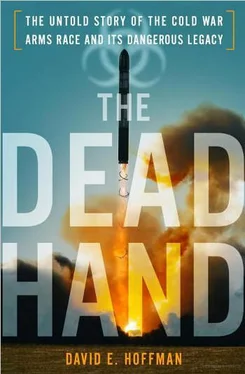But just as the Geneva Protocol a half century earlier had been weak, so was the new biological weapons treaty. It lacked on-site inspection mechanisms, because the Soviets had refused to accept any. It did not prohibit research if carried out for defensive purposes. At the time, Western diplomats reasoned it was better to get the treaty signed without verification than to have no agreement at all. The treaty simply left it up to each country to police itself. There were no penalties for cheating. There was no organization to monitor compliance.
Nixon had little faith in the new treaty. He was reluctant to even attend the signing ceremony. On the day he signed it, Nixon privately told Kissinger it was a “silly biological warfare thing which doesn’t mean anything,” and the next day, speaking to Treasury Secretary John Connally, he called it “that jackass treaty on biological warfare.” 5
The Biological Weapons Convention, which took effect on March 26, 1975, was the first post–World War II disarmament treaty in which an entire class of weapons was to be done away with. But the hopes for it were in vain.
In the winter months of 1972, Igor Domaradsky was recuperating from tuberculosis at a rest home outside of Moscow. One day, an official car arrived unexpectedly to pick him up. Domaradsky was driven to the Soviet health ministry in Moscow, and then to the Kremlin. High-Ranking officials told him that he was being officially transferred from Rostov to Moscow to work for an organization involving microbiology. They were vague about what Domaradsky would do. That summer, in preparation, he defended a new doctorate dissertation in biology. “Had I known what was in store for me I would not have wanted to do it,” he recalled later of the move to Moscow, “and I would certainly have refused.” 6He was assigned to work at a government agency, Glavmikro-bioprom, which was a shortened name for the main directorate of the microbiological industry. Originally, the agency was created to help improve agriculture and medicine, such as creating artificial sweeteners and proteins. When Domaradsky got a small office there, he recalled, he wasn’t sure why.
In the West, genetics and molecular biology were accelerating. The experiments of cutting, pasting and copying DNA fragments by Herb Boyer and Stanley Cohen in California were pushing the science of molecular biology to new levels. Many of the advances came just as Domaradsky was transferred to Moscow. The 1973 experiments of Cohen and Boyer marked the dawn of genetic engineering. 7
Soviet leaders made a momentous decision. Up to this point, their germ warfare program had been a military one. They had signed the new biological weapons treaty. But in deepest secrecy, they decided to violate the agreement, and to expand their pursuit of offensive biological weapons to exploit the new advances in genetic engineering. In the past they had used natural pathogens for weapons. Now they rushed to modify nature and create dangerous new agents. Domaradsky was recruited to be at the center of the program.
The germ warfare effort was far different from the nuclear arms race. Both superpowers formally negotiated on nuclear weapons. Nuclear weapons were legal by the rules of the day. The countries made treaties, set limits and went to great lengths to regulate the competition by arms control negotiations, which they discussed in the open. To protect against cheating, they created verification regimes. But when the Soviet leaders expanded their biological weapons program in the early 1970s, they moved into a dark underside of the arms race. The Soviet program was illegal by the terms of a treaty that Soviet leaders had signed. They broke their own promises, and there was no regulation, verification or enforcement. Their actions give the lie to decades of Soviet propaganda about seeking disarmament. Almost every participant in the Soviet program has said they assumed the United States was also cheating. But in fact the U.S. program had stopped.
At the time, Brezhnev was influenced by a leading molecular biologist, Yuri Ovchinnikov, vice president of the Soviet Academy of Sciences. He and several colleagues persuaded Brezhnev to harness the new genesplicing technology for offensive military purposes. According to Ken Alibek, who became deputy director of the Soviet biological weapons program, Ovchinnikov “understood the significance of what he had read in Western scientific journals, and he knew that there were no Soviet laboratories, and few Soviet scientists, equipped to match that level of work.” When it came to convincing the military of the value of this new quest, Alibek said, “Ovchinnikov was persuasive. The most skeptical military commander would have to agree that it was dangerous, if not outrageous, to be behind the West in anything. Ovchinnikov found an influential ally in Leonid Brezhnev. The onetime metallurgical engineer who led the Soviet Union for eighteen years until his death in 1982 regarded the magisterial akademiks of the Soviet scientific establishment with a respect bordering on awe. Ovchinnikov was soon giving private lectures on genetics to Brezhnev and his aides. Slowly the message sank in.” 8
The message was: they had to catch up. As part of the effort, Domaradsky recalled that several prominent Soviet scientists scoured the West for literature on molecular biology and genetics. Among them was Victor Zhdanov, a noted virologist who had initially proposed the global campaign to eradicate smallpox in 1958. Zhdanov won the high regard of Western scientists, and was often permitted to travel abroad. Domaradsky described Zhdanov as sophisticated and worldly. But Zhdanov was also aware of the terrible secrets—plans for a new generation of Soviet biological weapons.
In microbiology, a fine line exists between research that offers the promise of improved human life—better vaccines, drugs and agricultural products—and research that could be used to exploit human vulnerability to toxins and infectious disease. In the early phases, the same laboratory can be used for either purpose. Joshua Lederberg, the Nobel laureate, wrote that in biological weapons, the “underlying science is unalterably dual-use.” This allowed the Soviet leaders to hide their weapons program. 9
In 1973, soon after the treaty was signed but before it took effect, Brezhnev established a new organization, Biopreparat. The cover story would be that Biopreparat was making medicines and vaccines. But the truth was that Biopreparat was the dual-use mechanism for a recharged and ambitious Soviet effort to discover new offensive biological weapons. Under the cover of civilian pharmaceuticals, Biopreparat would be researching the most dangerous pathogens known to man. To guide it, Brezhnev ordered the creation of a secret, inner council. Brezhnev put the respected virologist Zhdanov in charge of the council, and Domaradsky was named deputy director.
Within the council, Domaradsky was also put in charge of a “special department” for planning biological weapons development. He had frequent contact with the military bioweapons laboratories, government ministries, Academy of Sciences, and security services. He was now at the “brain center” of the germ warfare research program. The code word for the new offensive weapons drive was “Ferment.” Eventually, it grew to employ tens of thousands of workers and received the equivalent of hundreds of millions of dollars in funding. 10
In 1974, the Soviet government issued another decree, this one public, seeking to accelerate Soviet work in microbiology. “The meaning of this order was clear,” Domaradsky said, “to let the nation and the world know that we had at last awakened and resolved to overcome our backwardness in this field.” 11But once again, the open decree was intended to conceal the truth. The Biopreparat-run laboratories were secretly intended for weapons work and were being erected at Koltsovo and Obolensk. By Alibek’s account, it was the most ambitious Soviet arms program since development of the hydrogen bomb. 12
Читать дальше












